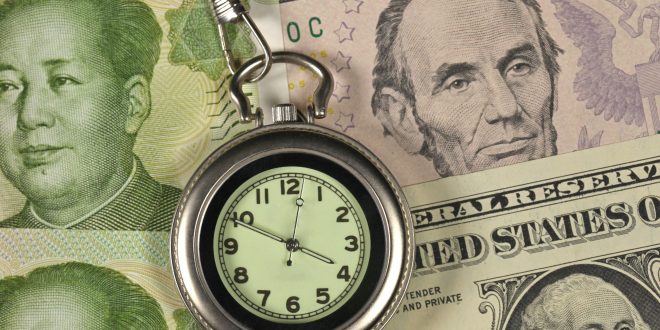Many markets around the globe are lifting lockdowns and preventive measures against the coronavirus (COVID-19), but the global pandemic continues to raise uncertainty after the recent increase in the number of new cases infected with the Delta variant.
Some vaccines are reportedly effective against the variant, including J&J and Moderna, while a recent Oxford study reportedly suggested that giving people two vaccines, with one in each dose, might lead to prolonged immunity. The studies vaccines were Pfizer- BioNTech and AstraZeneca.
Meanwhile, the Organization of the Petroleum Exporting Countries (OPEC) and other major producers, known together as the OPEC+ alliance, continue to discuss various points of view regarding output policy for the months ahead. A summit that was scheduled to be held last Wednesday was moved to Thursday, and talks continued the next day without reaching a definitive decision. Talks are set to resume on Monday.
Media reports have suggested the alliance could move towards increasing production by about 400,000 barrels per day, with a total increase by a couple of million barrels a day until the end of the year.
OPEC+ is currently applying a gradual easing of output cuts, as agreed in April, but yet to agree on the production policies and quotas for August and the following months.
In the U.S., the American economy showed the strongest increase in jobs since last August, as nonfarm payrolls (NFP) rose by 850,000 in June, with more signs showing improvement in the labor market, raising questions about when will the Federal Reserve identify substantial further progress, given the drop in initial jobless claims.
San Francisco Fed President Mary Daly expects the Federal Reserve will begin tapering asset purchases before the end of 2021 since the economy is strongly recovering.
The International Monetary Fund (IMF) has raised its projection for the U.S. growth rate in 2021 to 7%, up from 4.6% in April, while the Congressional Budget Office (CBO) has revised its growth forecasts upwards to 7.4% for 2021, followed by 3.1% in 2022 and 1.1% in 2023.
Forex
The U.S. Dollar (USD) showed a mostly positive performance against major peers but gave up its three-month high seen on Friday, as it continues to rise on the back of the recent hawkish change in tone by the Federal Reserve.
The Dollar Index (DXY), which measures the greenback against a basket of six major international currencies, rose by about 0.41% as it ended the week at 92.226.
The U.S. foreign trade balance showed an increase in deficit by 3.1%, with recovery pushing demand higher, while the jobs report and expectations for increased infrastructure further enhanced positive expectations.
The Euro (EUR) lost 0.61% against the rising greenback with the EUR/USD pair closing the week at 1.1865, falling for the first four consecutive sessions of the week before rising Friday as the Dollar eased.
The Sterling Pound (GBP) also lost about 0.38% to the USD, as the GBP/USD pair finished at 1.3830, narrowing its decline with the largest daily rise in about two weeks on Friday.
Meanwhile, the Dollar’s gains were smaller against the Japanese Yen (JPY), with the USD/JPY rising by 0.20% to 111.02, but maintaining an upward trend for four consecutive weeks, a period during which the pair rose by a combined 1.35%. This came despite the pair’s Friday loss that was the biggest since June 4.
The U.S. foreign-trade gap in goods and services expanded 3.1%, as consumers and businesses stepped up purchases of imported products and materials amid a continued economic recovery. A rebound in new factory orders in the U.S. in May, following a decline that exceeded expectations in April, also indicated moving in the same direction.
Meanwhile, slower growth in the U.S. manufacturing sector showed the recovery remains uneven while manufacturing activity in the Eurozone increased in June at the fastest pace on record.
As for the Canadian Dollar (CAD), the USD/CAD gained 0.24% despite the rising crude oil prices, after data showed that Canada’s real GDP contracted by 0.3% in April, an official reading that came better than market expectations.
Gold
The yellow metal maintained a positive performance for the last three sessions last week, to record its second consecutive weekly gain.
Gold futures for August delivery gained finished the week at $1,783.30 per ounce, its highest since June 23, rising by about $5.60 or 0.32%, amid the USD’s fluctuating performance.
A decline in Treasury bond yields also provided support for the precious metal, amid increased demand for safe havens due to reflation and COVID-19 concerns.
Oil
Oil futures recorded weekly gains, despite showing a mixed performance on Friday, after data showed an increase in the U.S. oil rig count by four, according to data by Baker Hughes.
Brent crude futures for September delivery finished the week at $76.17 per barrel, gaining 1.1%, and maintaining a rising trend for the sixth consecutive week.
The U.S. West Texas Intermediate (WTI) crude futures for August delivery closed at $75.16 per barrel, adding 1.5% on a weekly basis.
The market is still anticipating the decision by the OPEC+ on production policy, as well as market-moving political developments and its impact on output levels, amid general optimization regarding demand recovery in the second half of the year, despite concerns about the Delta variant.
Cryptocurrency
Despite rebounding over the past few days, data showed that Bitcoin dropped by 41% during the second quarter (Q2) of 2021. A strong selloff, not seen since Q4 of 2018, led to the losses of the world’s largest digital currency.
The rebound of cryptocurrencies helped the Coinbase Global stock surge to closing levels not seen since mid-May, before finishing the week at gains but below its weekly highs, on the back of increased institutional investments.
Crypto assets are seemingly shaking off concerns about the recent crackdown in China and other places.
After the Chinese government moved against Bitcoin mining and trading due to concerns over high energy consumption and financial risks, market regulators in the U.K. are putting increased scrutiny on crypto, following a decision by the Financial Conduct Authority (FCA) to ban Binance, an exchange that was expected to launch a new digital asset marketplace in Britain. Moreover, Japan’s Financial Services Agency also said that Binance was operating in the country illegally.
Stocks
European stocks closed lower for the week, amid a mixed performance by leisure and travel stocks, and losses by the banking sector, and concerns about the COVID-19 Delta variant.
The STOXX Europe 600 index lost 0.82 points or 0.18% for the week, as it closed at 456.81 points.
The French CAC 40 index finished lower by 70.01 points, or 1.06%, on a weekly basis, in its worst weekly performance since the week ending on February 26.
Similarly, the UK’s FTSE100 declined by 12.80 points, or 0.18%, for the week and closed at 7,123.27 points.
On the other hand, the German DAX managed to recover from earlier losses on Friday, added to end the week at 15,650.09 points, rising by 0.27%.
In Wall Street, the S&P 500 continued to close at a new record high for seven consecutive sessions, setting a new record-long streak of record-breaking activity no seen in more than 20 years, and finished the week higher by 1.7% at 4,352.34 points.
The Nasdaq Composite also set a new record at 14,639.33 points, gaining about 2% for the week, while the Dow Jones Industrial Average rose by 1%.
In Asian markets, Japan’s Nikkei closed lower for the week by 0.97%, while the broader Topix lost 0.32% after rising last week, due to COVID-related concerns.
Japan is likely to extend coronavirus containment measures for two weeks or more in the greater Tokyo area.
 Noor Trends News, Technical Analysis, Educational Tools and Recommendations
Noor Trends News, Technical Analysis, Educational Tools and Recommendations





